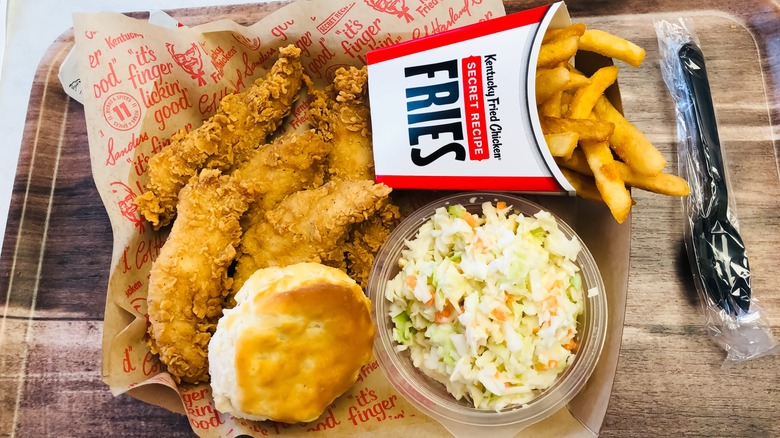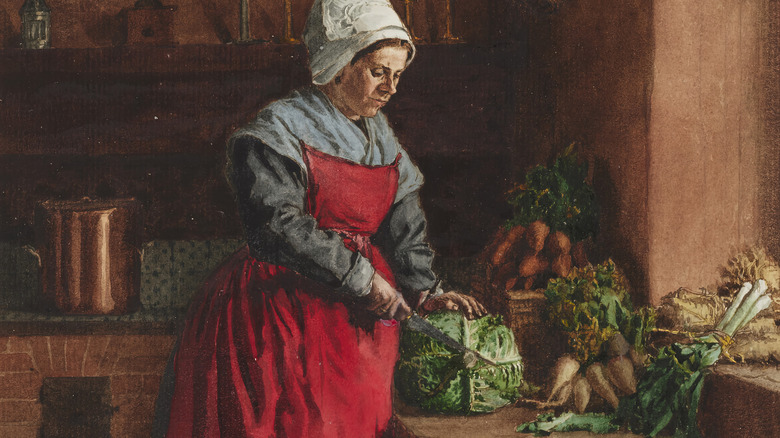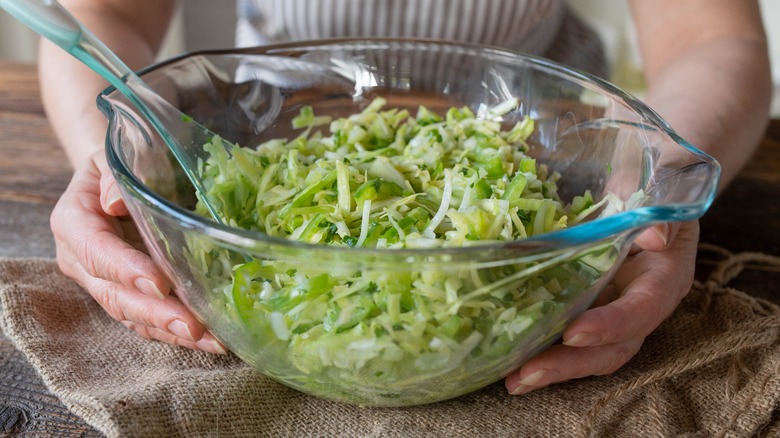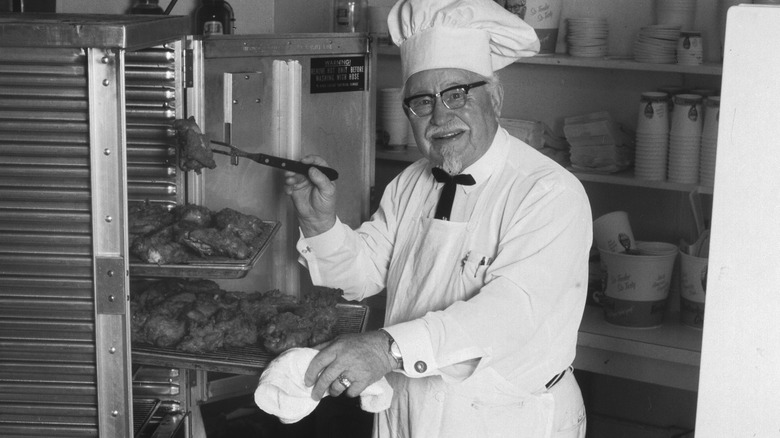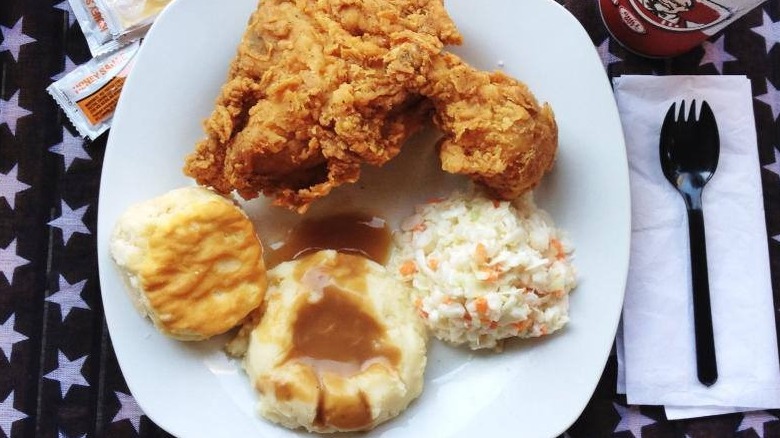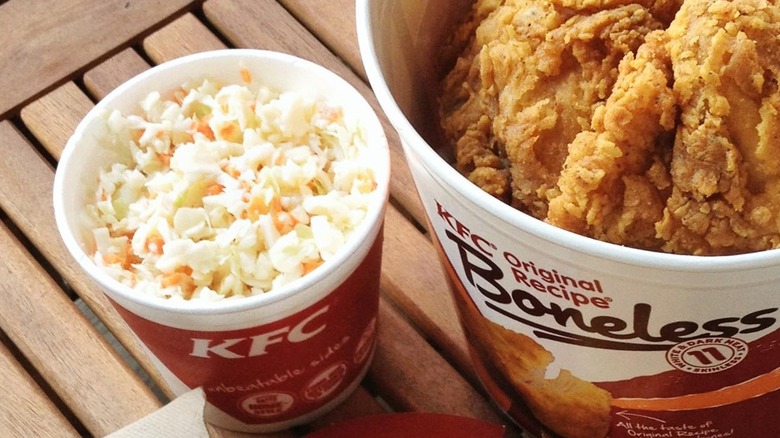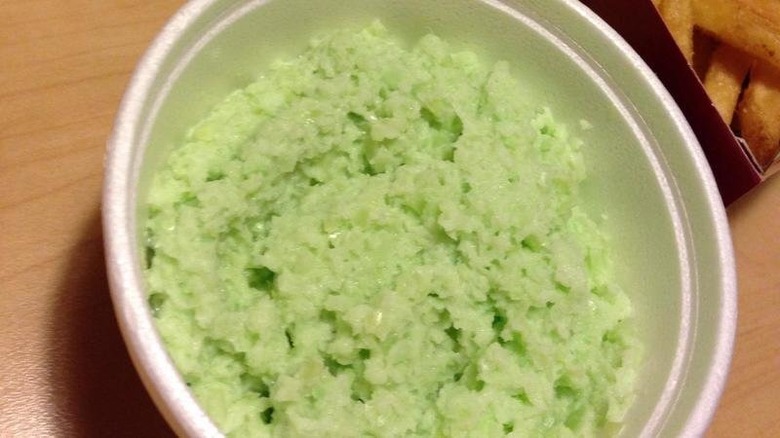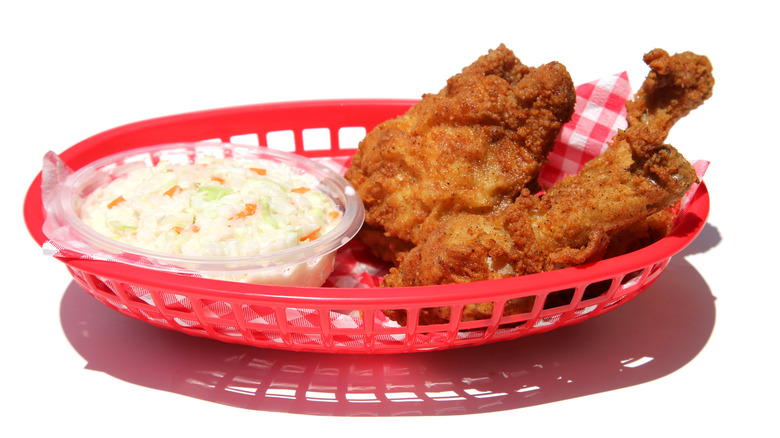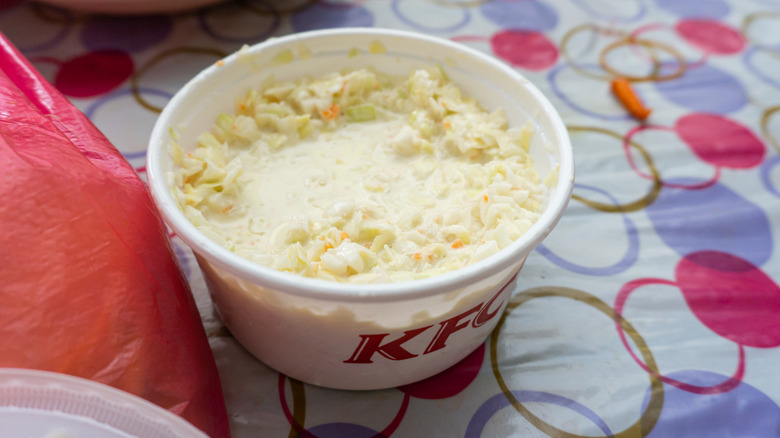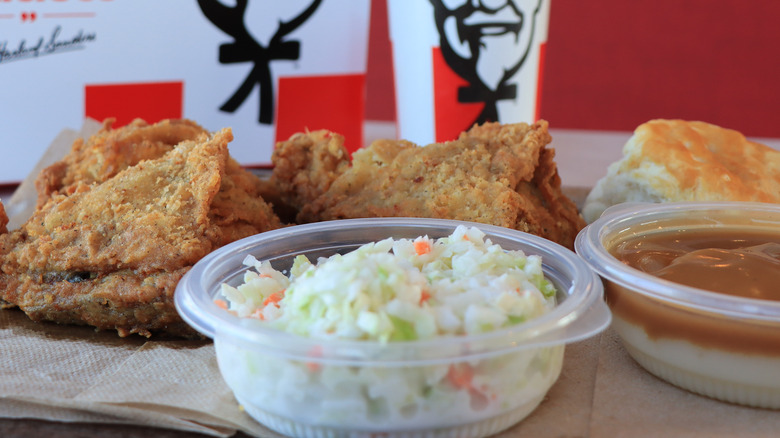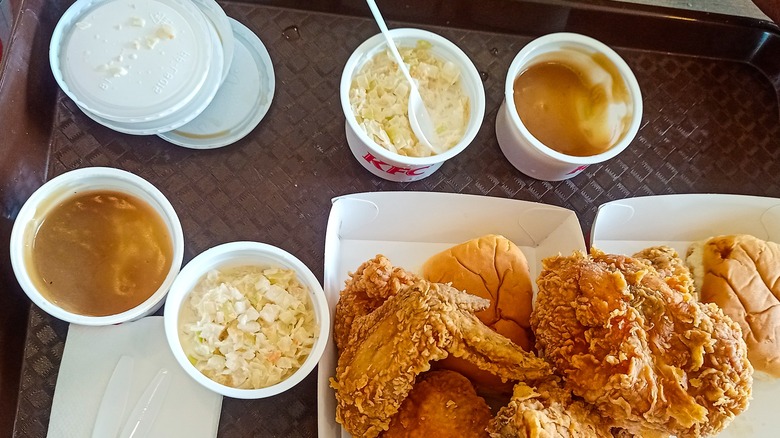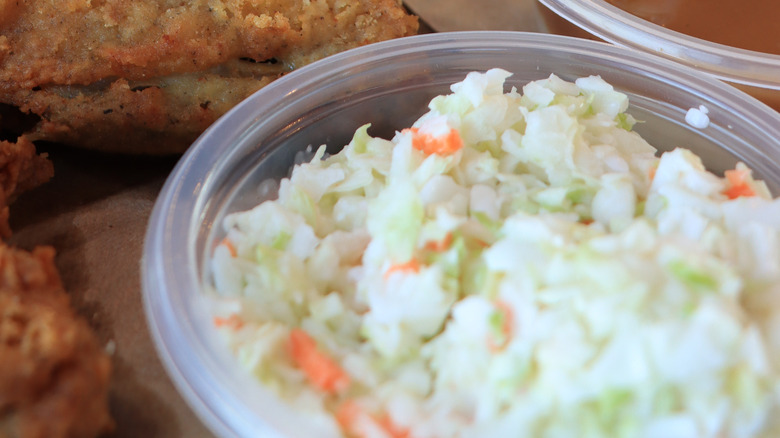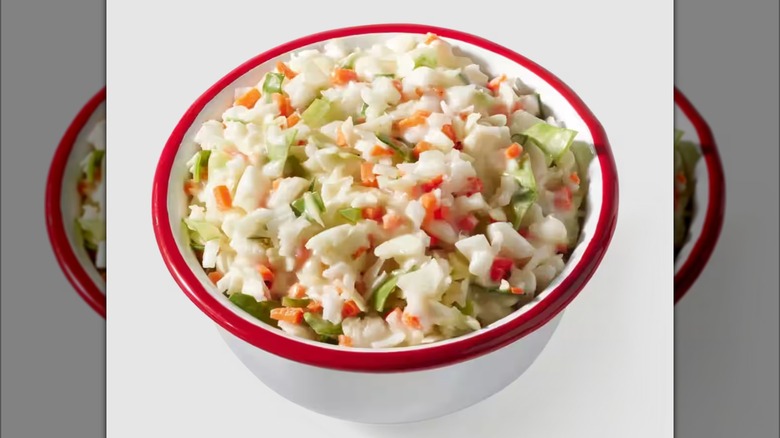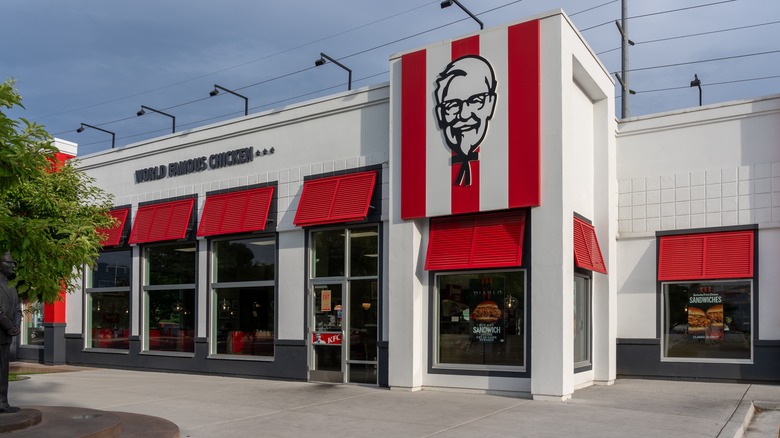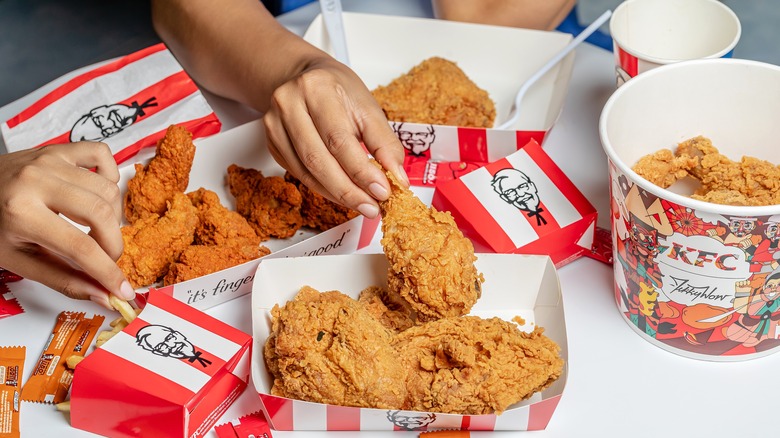The History Behind KFC's Famous Coleslaw And What Makes It So Good
As the unofficial 8th Wonder of the World, KFC's coleslaw transcends time and cosmic shifts in fast food tastes to remain one of the most popular menu items of modern times. So what's the story behind the coleslaw with the cult following? Here's why you can't get enough.
Easily outpacing trendier items at the fried chicken chain, this iconic coleslaw gives newer dishes like the KFC Famous Bowl the side-eye, seemingly wondering if the nugget-topped mashed potato bowl even goes here. This cabbage means business.
It's a tangy, sweet, and crunchy take on a centuries-old invention, that's been on heavy rotation since the KFC menu was born. It survived a coleslaw shortage and an international green-hued era and still tops the ranks in customer orders –so beat it, mac and cheese! Work up a hearty appetite by digging into the history behind KFC's famous coleslaw and what makes it taste so dang good. Whatever you do, just don't call it a side dish.
Coleslaw is a 250-year-old dish
Nope, coleslaw was not invented by your Great Aunt Mildred to torture you and your cousins at potlucks. In reality, the earliest known version of the slaw was first drummed up by the Roman Empire.
Back then, mayo was not yet a thing so the ancient Roman recipe featured cabbage, eggs, spices, and vinegar. Dutch immigrants then brought the salad recipe to New York City in the late 1700s, adding rich-tasting butter to the crunchy salad mix.
Fans of the more decadent mayo version of coleslaw had to wait until, well, mayonnaise was invented. With reports pointing to a cream and egg blend being whipped up by a French chef in the mid-1700s, most scholars agree on citing the era as the point when mayo went mainstream. It wasn't long before everyone's minds were blown by a cabbage salad that didn't taste like plain ol' cabbage anymore. But what would they call this magical dish?
The name coleslaw comes from the Dutch koolsla
Raise your hand if you ever thought this cabbage-y salad was called "cold slaw." (Well, it does make more sense, right?) Just to set the record straight, this dish is not spelled "cold slaw," despite often being plucked from the fridge before serving. And to back this up, I've got some intel on coleslaw's true origin story.
The original term comes from the Dutch words for cabbage (kool) and salad (sla), forming koolsla. (I know, it's still confusing with the word kool, and then cool temperatures thanks to whatever damage the Kool-Aid brand misspelling did to your mind as a child.)
According to the dictionary, there was a brief transitional time between the Dutch native pronunciation and the emergence of the Anglicized "coleslaw" version, where people were reportedly living too fast and free and calling it "cold slaw." Apparently, they quickly discovered you can also eat the stuff at room temperature so that terminology had to go. With the root "cole" (Old English as "cal") also leading back to the Latin term for cabbage (caulis), all signs pointed to using the term coleslaw for this popular dish. (Put any leftovers in the fridge, so it stays "kool," k?)
In 1952, KFC coleslaw cost 50 cents per pint
Back in 1952, Salt Lake City, Utah became home to the first-ever KFC franchise. And what, pray tell, was listed on that original menu? Our scrappy little friend, coleslaw (and a bunch of other future hits).
According to a menu posted to Reddit, which reportedly hails from the first year of the company's existence, creamy coleslaw can be found as one of eight options under "The Colonel's Salads." Available back then for 50 cents a pint, the cabbage salad took off running while other sides like liver and gizzards didn't quite stand the test of time. (Whipped potatoes, fries, pies, and Family Buckets were other original stars that you'll still find on the menu.)
Just for fun, the average person earned an annual income of roughly $2,300 in 1952; a salary that sounds a little better as 4,600 pints of KFC coleslaw. These days, a large KFC coleslaw can cost up to $5. With the average earner making roughly $59,384 in 2023 (or the equivalent of 11,876 large orders of KFC coleslaw), it appears that this fast food chain has done its best to keep prices in check over the decades.
The secret to KFC coleslaw is chopped (not shredded) cabbage
Okay, so what's in the freakin' coleslaw that makes it such a fan favorite? Cabbage! Stay with me though because it's a special kind of cabbage (Not that kind).
Cabbage features heavily in coleslaw preparation, but there's a strategy for crafting the perfect recipe. And it's not always about dehydrating the veg so you don't end up with soggy slaw. KFC coleslaw is made with cabbage that's chopped so fine, that it almost seems minced — all in the name of collecting as much creamy dressing as possible. As a reporter once noted for The Spokesman-Review, "On orders from the good Colonel himself, KFC decided to finely chop its cabbage instead of shredding it ... This allows the mayonnaise dressing to cling to the cabbage with hardly a drip."
While plenty of copycat recipe videos feature home cooks chopping cabbage into smithereens as they attempt to attain KFC coleslaw status, behind-the-scenes videos from KFC employees show cabbage that arrives at the store, already chopped. This chain may be cagey about how they dice their cabbage into Barbie-sized portions, but that doesn't matter. All you have to do is eat it.
KFC also finely chops the carrots in its coleslaw
Another secret behind KFC's coleslaw recipe is this: really tiny carrots. They're so small, that you might have even forgotten that there are actually carrots in KFC coleslaw. (Trust me, they're in there.) But that barely noticeable carrot-esque presence is exactly why this salad works.
Chef and author of "Top Secret Recipes Unleashed," Todd Wilbur describes KFC coleslaw on the Today site as, "Hands down, the most popular coleslaw in the country, and probably in the world." For his professional dupe on the beloved recipe, he advises, "Be sure cabbage and carrots are chopped up into very fine pieces (about the size of rice)." While common salad-making knowledge suggests that similar-sized, bite-friendly ingredients create the most appealing mix, it seems that KFC said, okay cool, let's just do that, but make it micro.
Even little bits of carrots pack healthy vitamins and minerals like beta-carotene, potassium, and biotin. But as for whether a serving of KFC coleslaw comprises even the equivalent of one baby carrot is a question we'll just have to keep eating coleslaw to answer.
KFC coleslaw used to be green in Canada
Have you seen any pics of odd-colored KFC coleslaw on the internet lately? Probably not, because the lime green version of this recipe is — sadly for some — no longer on the market.
Thank KFC Canada for this beloved coleslaw that made an abrupt exit in 2017. There was even a Change.org petition that seemed determined to bring the green slaw back. The original poster claimed she had eaten the green stuff since she was a child and was shocked to find that it had been replaced by the white, slightly carroty version. "If I wanted veggies I would go somewhere healthy, but when I want my chemically altered deliciousness of my dreams I go to KFC and get an individual order of Coleslaw," she declared. KFC ignored the cries of the people, leaving the white slaw in rotation.
Was it added food coloring that was intended to badly imitate the pastoral grassiness of fresh cabbage? While the actual green part of KFC Canada coleslaw remains a mystery, some have guessed that it was once made with parsley which caused the electric lime hue.
The original KFC coleslaw recipe had horseradish in it
Speaking of ingredients that used to be in the KFC coleslaw recipe, there was a time when horseradish was part of the mix. While modern palates accept horseradish in everything from hot sauce to spicy cocktails, back in the day, somebody in the KFC test kitchen decided horseradish had to go.
As a copycat KFC coleslaw recipe author noted for Parade, the original version may have incorporated the tiniest bit of horseradish into the mix. While finely chopped (of course they're finely chopped) onions now do the work of adding a little sharpness to the flavor profile, there are still KFC early adopters who remember the unmistakably spicy punch of the horseradish era.
Horseradish produces a natural chemical called allyl isothiocyanate which gives it the peppery, piquant flavor that you also taste in radishes, wasabi, and mustard. Onions, on the other hand, unleash several compounds when cut, like 1-propenyl sulfenic acid, which ultimately gives the veg its sulfur-like pungence. This straight onion-ness makes them the perfect complement to the creamy mayo dressing in KFC coleslaw. Speaking of mayo ...
KFC's coleslaw recipe's satisfying creamy dressing
Look away, fans of mayo-free coleslaw, because KFC has been slinging creamy, milky slaw since way back when. While the luscious secret recipe also likely features tangy ingredients like buttermilk, lemon juice, and vinegar, it's the greater mayonnaise blend that makes this one a hit with fans.
If you've seen the TikTok videos from KFC employees revealing how they mix the coleslaw by hand, you've also probably noticed that the slaw's dressing gets shipped to the store in pre-packaged bags. The source ingredients remain somewhat of a mystery, but as far as the creaminess is concerned, we can reliably guess that mayonnaise creates the foundation. Unlike, say, a vinegar-based coleslaw dressing, mayo was made to lock in the cravings.
As you might experience any time you enjoy ice cream, cheese, or milk, the human body's got a thing for creamy foods. According to KFC's official list of coleslaw ingredients, whole eggs — the yolks of which contain a nutrient called choline, which has mood-soothing properties, notes the National Institutes of Health — are likely part of the dressing blend. Then there's the fact that the creamy texture itself is comforting, too. Nutritionist and author Kimberly Snyder explained to Everyday Health, "We often crave foods with specific textures — crunchy, soft, creamy, or smooth — and these textures correspond to particular emotions." And now back to my emotional support KFC coleslaw.
It's easy to crave the fat in KFC coleslaw
Remember that creamy dressing situation we just talked about? KFC coleslaw offers yet another bingeable feature: fat — a whopping 12 grams of fat per regular order, to be exact. (Wait, what? Isn't this a vegetable side?)
Back to the KFC nutrition guide, it's easy to spot where the fat content comes from. Listed just after sugar, soybean oil probably boosts the fat content the most, followed by the addition of whole eggs.
While you can eek out some healthy fatty acids and oils from almost any mayonnaise recipe to get a little vitamin E, this $6 billion fast food chain likely prioritizes the mouthfeel of a creamy dressing you won't want to stop eating; plus its habit-forming fat content. According to Cell Metabolism, studies have revealed a nerve pathway from your gut to your brain that triggers your brain's reward center, sending the message that more fat (enter KFC coleslaw) equals more good vibes — and to keep it coming. (Your brain's probably doing backflips just thinking about it.)
KFC coleslaw is packed with sugar
It's not just the fats in KFC coleslaw bringing all the boys to the yard (or to the parking lot of the KFC). As anyone with a sweet tooth can attest, sugar also electrifies the pleasure sensors in the brain.
KFC coleslaw goes in hard on the sweetener with a whopping 10 grams of added sugar in a regular order. Where does all that sweet flavor come from? I'm not a dietician, but even though there are many varieties of sugar, a quick peek at the nutrition information for this dish makes me think the term "sugar" would be the prime suspect. Based on the KFC reconnaissance I've been able to do via TikTok, I would bet a 16-piece chicken family bucket on sugar being part of the creamy dressing, not the slaw.
Studies have proven that excess amounts of sugar in popular fast food items can sometimes be caused by additives designed to extend shelf life, or create a more pleasing texture or color. But, surprise, our bodies also happen to really love sugar. Back to Cell Metabolism and that gut-brain connection, there's another pathway designed specifically for the sweet stuff, so your belly can quickly tell your brain that your body loves that sweet, sweet KFC coleslaw. While carrots and cabbage naturally contain small amounts of sugar, it's the added sugar that sends dopamine into overdrive without offering any valuable nutritional benefit.
The crunch in KFC coleslaw signals pleasure in the brain
As it turns out, the irresistible crunch of even the itty bitty veggies in KFC coleslaw triggers pleasure sensors in your brain. (It's like everything about this recipe is working for it.)
If there's a difference between crispy and crunchy, somebody better send a message to your brain which basically gets its own contact high off the chomp-worthy textures in your mouth. (It also gets the munchies, so bust out the snacks, stat.)
"Sound affects the experience of food," University of Oxford professor and gastrophysicist Charles Spence told Mental Floss. "The noise draws attention to the mouth in the way something silent does not ... A crunch will draw your attention to what you're eating, making you concentrate on it. Noisy foods make you think about them."
So, you're saying KFC coleslaw is good for the mood as well as boosting a sense of overall contentedness? Cancel the regular order and make that a family homestyle size — this meal is about to be the most delicious self-care ritual on the internet.
The cool temperature of KFC coleslaw is refreshing
It's fatty, creamy, sweet, and crunchy, but KFC coleslaw boasts yet another fanatical feature: a cool temperature. So how come cooler foods are enticing? Us consumers like to feel refreshed.
Contrary to cold contact on your skin (which commonly creates discomfort for most people), cold contact inside your mouth has been scientifically proven to feel freakin' awesome to many diners. Enjoy eating ice cream, popsicles, or sipping water with the perfect amount of nugget ice? Then you probably also love cold salads, sandwiches, leftover pizza, and KFC coleslaw straight out of the fridge.
Other studies show that people buy and consume more food when it's served cold, versus hot. Food temperature that hits lower than 59 degrees Fahrenheit (industrial walk-in refrigerators are regulated to be roughly 35 to 45 degrees Fahrenheit) typically tastes milder, too — so you can eat more of it, compared to warm food. Is this all part of a Kentucky-fried conspiracy to get consumers to buy more coleslaw? Just keep eating coleslaw and nobody gets hurt. (Insert smiley-face emoji, please.)
There was a KFC coleslaw shortage in 2022
Now that we're clear on why nearly all of humanity is fully owned by KFC coleslaw, you can imagine what a shock it was when the coleslaw completely disappeared from the menu in New Zealand. It eventually returned, but please allow a moment of silence for those trying times.
Thanks to issues in the supply chain, KFC coleslaw went dark on loyal Kiwis in 2022 due to there being no dressing with which to toss the cabbage mix. "Feels like a sign of the apocalypse," reported one person to a local news outlet. Ghosting consumers like a creeper on Tinder, the fast food chain abandoned sales of the cabbagy side without warning, leaving many customers in the lurch. Someone else shared, "Am I dreaming? No coleslaw. I can never have KFC again without it." The side slid back into the lineup by December of that year.
While New Zealanders responded to the situation with relative civility, a different coleslaw shortage years prior erupted in semi-violence. According to a KFC employee's 2017 account of a week-long coleslaw shortage at their unnamed store, one customer who couldn't believe there would be no coleslaw resorted to throwing a tantrum that involved napkins, cups, and restaurant chairs. Luckily, the staffer explained to Cosmopolitan, "I offered him two mac and cheese sides and extra chicken in his 20-piece bucket, which he accepted as a replacement, and we were able to get him out of the restaurant."
Tangy flavors in KFC coleslaw contrast rich fried chicken
The agreed-upon term for just how well KFC coleslaw goes with the chain's signature fried chicken is "no-brainer." Beyond all the science behind the recipe, the deliciously cool temperature, and the diced veggies, this might be KFC coleslaw's greatest asset: It just tastes really good with chicken. (But why though?)
Landing on the contrasting side of the sides menu, the tangy flavors in KFC coleslaw serve to brighten the rich, fatty flavors of the chicken, as opposed to, say, mac and cheese which acts like two peas in a pod by adding more sodium to already-savory flavors. The acid in the coleslaw, coming from vinegar and lemon juice, also serves to break up the fats in your mouth from the fried chicken skin, making your KFC meal a supreme joy to eat.
All of this coleslaw talk is making me hungry. But wait — you don't have to hit the drive-thru for awesome fried chicken. Just grab the vodka to cook the crispiest fried chicken at home. (I promise this is a real recipe and not a link to my liquor cabinet crowdfunding site.) Cheers!

